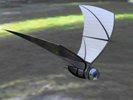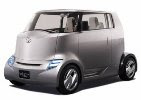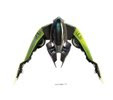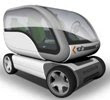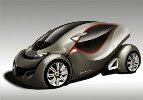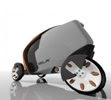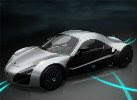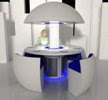 Chess is a cell-car concept where passengers are put in a cell above a platform containing the engine and wheels. The cell can move over the platform in any direction. If a sensor, placed in the platform, detects a possible crash, the passenger-cell is moved away from the expected impact area. This results in more (deformable) distance between impact and passengers, thus higher survival-chances. Depending on position, speed, and place of impact, the passenger-cell moves to the most optimal position to protect the occupants.
Chess is a cell-car concept where passengers are put in a cell above a platform containing the engine and wheels. The cell can move over the platform in any direction. If a sensor, placed in the platform, detects a possible crash, the passenger-cell is moved away from the expected impact area. This results in more (deformable) distance between impact and passengers, thus higher survival-chances. Depending on position, speed, and place of impact, the passenger-cell moves to the most optimal position to protect the occupants.

At a side-impact crash, the doorstep moves out to create an extra buffer, this way, the passengers are positioned in the most possible protected area.


 Designer : Thijs van der Zanden & Frans Hegge
Designer : Thijs van der Zanden & Frans Hegge
Chess, Cell-Car Concept
Embryo Car Concept
 With expanding cities and dearth of parking spaces, more and more emphasis is being given to ecological vehicles. The vehicles are designed on aspects such as space and security elements. Goran Marinkovic has come out with what he calls Concept Embryo, a two-seater urban vehicle.
With expanding cities and dearth of parking spaces, more and more emphasis is being given to ecological vehicles. The vehicles are designed on aspects such as space and security elements. Goran Marinkovic has come out with what he calls Concept Embryo, a two-seater urban vehicle.

Concept Car Embryo is powered by fuel cells which uses clean fuels like hydrogen. It is completely ecological as it is made of recyclable aluminum and silicon materials used mostly for interior elements. Design wise, it looks like an organism, however safety wise too, it derives the same thought. Soft material is used for exterior while inside it has a protective layer to absorb the impact and keep the passengers safe. The safety system also acts as a communicating system for information like speed, distance etc. and if necessary auto pilot also reacts to avoid possible accidents. With all these safety and design features it surely is a winner in robotic era.



Designer : Goran Marinkovic
The Solar Powered COM-BAT Spy Plane
 In this season of specters and spooks, what could be scarier than a steel-winged robotic spy plane shaped like a bat? The aptly named COM-BATis a six-inch surveillance device that is powered by solar, wind, and vibrations. The concept was conceived by the US military as a means to gather real-time data for soldiers, and the Army has awarded the University of Michigan College of Engineering a five year $10-million dollar grant to develop it.
In this season of specters and spooks, what could be scarier than a steel-winged robotic spy plane shaped like a bat? The aptly named COM-BATis a six-inch surveillance device that is powered by solar, wind, and vibrations. The concept was conceived by the US military as a means to gather real-time data for soldiers, and the Army has awarded the University of Michigan College of Engineering a five year $10-million dollar grant to develop it. 
The grant will establish the University of Michigan Center for Objective Microelectronics and Biomimetic Advanced Technology, called COM-BAT for short. The center will focus upon developing sensors, communication tools, and batteries for “the bat”. Some concepts that they are working on include tiny cameras for stereo vision, an array of mini-microphones capable of tracking sounds from different directions, and small detectors for nuclear radiation and poisonous gases. The design will also feature “quantum dot solar cells” that are twice as effective as current photovoltaics, in addition to an autonomous navigation system that is 1,000 times smaller than current systems.
Some concepts that they are working on include tiny cameras for stereo vision, an array of mini-microphones capable of tracking sounds from different directions, and small detectors for nuclear radiation and poisonous gases. The design will also feature “quantum dot solar cells” that are twice as effective as current photovoltaics, in addition to an autonomous navigation system that is 1,000 times smaller than current systems.
Car Concept from Toyota : Hi-CT Hybrid Car
 Toyota Hi-CT hybrid concept car offers an enjoyable vehicle with weird looking design, but according to Toyota’s team of young Japanese and European designers, this is the reflection of what a cool and great vehicle should look like. The idea behind this hybrid concept car is the theme of “unbalanced”, creating something that make people stop and take a good look.
Toyota Hi-CT hybrid concept car offers an enjoyable vehicle with weird looking design, but according to Toyota’s team of young Japanese and European designers, this is the reflection of what a cool and great vehicle should look like. The idea behind this hybrid concept car is the theme of “unbalanced”, creating something that make people stop and take a good look.
 The Hi-CT is a plug-in hybrid with a 1.5L motor and uses lithium-ion batteries, which are located underneath the floor of the vehicle in order to maximize the interior space of the car. While it looks quite boxy and big, it is in fact quite small. The entire vehicle is 3.3 meters long, 1.6 meters wide and 1.7 meters high. It is, effectively, a cube on wheels. Due to the tiny size, it can only carry two persons. However, being a 'lifestyle' car, there's enough space inside it for everything that an active user or two could need. The rear trunk can be modified so that surfboards, bicycles and camping equipment can be carried around for those days where you need to get out to nature.
The Hi-CT is a plug-in hybrid with a 1.5L motor and uses lithium-ion batteries, which are located underneath the floor of the vehicle in order to maximize the interior space of the car. While it looks quite boxy and big, it is in fact quite small. The entire vehicle is 3.3 meters long, 1.6 meters wide and 1.7 meters high. It is, effectively, a cube on wheels. Due to the tiny size, it can only carry two persons. However, being a 'lifestyle' car, there's enough space inside it for everything that an active user or two could need. The rear trunk can be modified so that surfboards, bicycles and camping equipment can be carried around for those days where you need to get out to nature.
 The interior looks futuristic, I don’t really care anymore about the outside look. Those young designers surely think outside the box when they designed this car.
The interior looks futuristic, I don’t really care anymore about the outside look. Those young designers surely think outside the box when they designed this car.
Futuristic Car Concept from Honda : Combination of Marine, Jet, Robotic, and Automotive
 Here comes something beyond our imagination. The Great Race 2025 is a futuristic concept car created by Honda. This design is surely inspired by some dragon games because the design looks like an unbelievable car with dragon wings that can be used to fight and travel any kind of track. The concept is designed to fulfill all the demands of a great race in 2025 which will be a toughest race ever devised. The vehicle’s sonar sensors are smart enough to detect the changes in speed, terrain and altitude. If you have enough credit to afford this vehicle, then you must go for it.
Here comes something beyond our imagination. The Great Race 2025 is a futuristic concept car created by Honda. This design is surely inspired by some dragon games because the design looks like an unbelievable car with dragon wings that can be used to fight and travel any kind of track. The concept is designed to fulfill all the demands of a great race in 2025 which will be a toughest race ever devised. The vehicle’s sonar sensors are smart enough to detect the changes in speed, terrain and altitude. If you have enough credit to afford this vehicle, then you must go for it.
 Text from designer :
Text from designer :
In 1908, 17 men dared to take on the “toughest race ever devised.” Spanning six months, the Great Race brought these men over 22,000 miles, through three continents and around the world. 117 years later, the Great Race of 2025 is tougher than ever. Competitors must circumnavigate the globe in 24 hours on land through the United States, by sea through Asia and by air over Europe.
Competitors must circumnavigate the globe in 24 hours on land through the United States, by sea through Asia and by air over Europe. The vehicle’s sonar/echolocation sensors are able to detect changes in speed, terrain, and altitude, allowing it to switch to any configuration. With expertise in automotive, marine, robotics, and jet technologies already in place, Honda possesses a distinct, competitive advantage over its rivals, allowing it to lead in the evolution of motorsports in the 21st century.
The vehicle’s sonar/echolocation sensors are able to detect changes in speed, terrain, and altitude, allowing it to switch to any configuration. With expertise in automotive, marine, robotics, and jet technologies already in place, Honda possesses a distinct, competitive advantage over its rivals, allowing it to lead in the evolution of motorsports in the 21st century.

 Designer : Franco Corral
Designer : Franco Corral

